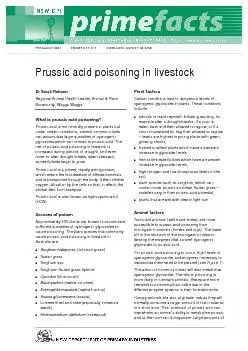/


Travelling stock and recently introduced stock are at greater risk as they are unaccustomed to local plants There is also evidence that animals become accustomed to the poison and with experience can ID: 146545
Download Pdf The PPT/PDF document "prussic acid can, therefore, be absorbed..." is the property of its rightful owner. Permission is granted to download and print the materials on this web site for personal, non-commercial use only, and to display it on your personal computer provided you do not modify the materials and that you retain all copyright notices contained in the materials. By downloading content from our website, you accept the terms of this agreement.
prussic acid can, therefore, be absorbed and lead Travelling stock and recently introduced stock are at greater risk as they are unaccustomed to local plants. There is also evidence that animals become accustomed to the poison and with experience can tolerate increasing amounts. Signs of poisoning Signs of poisoning usually occur 15–20 minutes after the toxin is consumed. Death occurs very quickly, approximately 2–3 minutes after the onset of clinical signs in peracute cases, and within 1–2 hours in acute cases. Usually, animals are found dead with no signs observed. The brain and heart are the first to be affected by lack of oxygen, and so the resulting clinical signs prior to death include: breathing difficulties rapid, weak, irregular pulse anxiety and restlessness followed by depression stumbling/staggering muscle tremors moaning dilated pupils recumbency bloat, and sometimes salivation and vomiting terminal convulsions bright red mucous membranes. Diagnosis A diagnosis of prussic acid poisoning is made on clinical and/or post-mortem findings and by the recovery of the poison from the plants/feed and On post-mortem examination, the blood may also be bright red and clot poorly (the blood will return to a dark colour a few hours after death). Muscles the trachea and lungs. Haemorrhages will be evident on the surface of the heart. There may also be a smell of bitter almonds in the rumen. Samples for laboratory analysis include rumen contents (which should be frozen as soon as possible), muscle, liver and a sample of feed. Figure 1. Process of prussic acid poisoning betase glycosida lysase Cyanogenic glycoside alpha hydroxynitrile aglycone prussic acid (HCN) lives r enzyme HCN + aldehyde or thiocyanate excreted in urine Prussic acid poisoning can be confused with: nitrite poisoning acute pulmonary oedema and emphysema blue-green algae poisoning anaphylactic reactions. Treatment Urgent veterinary attention is necessary. It is essential to obtain the correct diagnosis, as confusion with nitrite poisoning may be disastrous. (See Primefact 415 Nitrate and nitrite poisoning in Treatment aims to re-establish oxygen transport at the cellular level. Sodium nitrite is injected intravenously to convert haemoglobin to methaemoglobin, which reacts with cyanide (prussic acid) to form cyanmethaemoglobin. A simultaneous injection of sodium thiosulfate provides sulfur to convert cyanmethaemoglobin to the non-toxic thiocyanate, which is excreted in the note below.) An alternative treatment is to inject a large dose of sodium thiosulfate alone. This is the preferred treatment if there is suspicion that prussic acid poisoning is combined with nitrate poisoning. Treatment will need to be repeated. (See note below.) Animals should be removed from the source of poison immediately and fed safe feed to help dilute the amount of poison in the rumen/stomach. Animals exposed to the poison source should be signs. Animals should be handled as quietly as Sodium nitrite and sodium thiosulfate are not approved for use in food-producing animals.This matter is under review. Contact your Prevention Do not allow stock to graze risky food sources. Have feed analysed if safety is in doubt. PRIMEFACT 417, PRUSSIC ACID POISONING IN LIVESTOCK 2